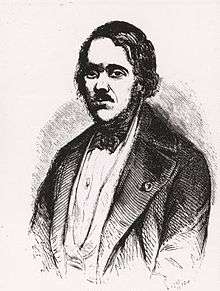Francis de Laporte de Castelnau
François Louis Nompar de Caumont La Force, comte de Castelnau (25 December 1810[1] – 4 February 1880) was a French naturalist, known also as François Laporte or Francis de Castelnau. The standard author abbreviation Castelnau is used to indicate this person as the author when citing a botanical name.[2], and zoological names other than insects. However, Laporte is typically used when citing an insect name (e.g.[3],[4]), or Laporte de Castelnau (e.g.[5]).

Life
Born in London, Castelnau studied natural history in Paris. From 1837 to 1841 he led a scientific expedition to Canada, where he studied the fauna of the Canadian lakes and the river systems of Upper and Lower Canada (roughly corresponding to the modern provinces of Ontario and Quebec) and of the United States.[6]
Castelnau, a French savant, was sent by Louis Philippe, in 1843, with two botanists and a taxidermist, on an expedition to cross South America from Rio de Janeiro to Lima, following the watershed between the Amazon and La Plata river systems, and thence to Pará. He was gone for five years.[6] In 1856-57 he visited the Cape of Good Hope, travelling as far east as Algoa Bay, and subsequently wrote a treatise on South African fish (1861). [7]
He served as the French consul in Bahia in 1848; in Siam from 1848 until 1862, and in Melbourne, Australia from 1864 to 1877.[6]
Hoax Australian fish

Through no fault of his own, Castelnau's name is attached to an Australian hoax. "Ompax spatuloides ", a supposed ganoid fish said to have been discovered in 1872 and named by Castelnau, was a joke originally directed at Karl Staiger, the director of the Brisbane Museum. Staiger forwarded a sketch and description of the made-up fish to Castelnau, who duly described it.[6]
Legacy
Castelnau is commemorated, among others, in the scientific name of a species of Australian gecko, Oedura castelnaui,[8], of a species of ground beetle, Megacephala castelnaui, a species of scarab beetle, Hybosorus laportei, an aphid Cinara laportei, and of the spotback skate, Atlantoraja castelnaui.
Works
- Histoire naturelle, 1837.
- Vues et souvenirs de l'Amérique du Nord
- Expédition dans les parties centrales de l'Amérique: histoire naturelle des insectes coléoptères, 1840.
- with Hippolyte Louis Gory Histoire naturelle et iconographie des insectes coléoptères, publiée par monographies séparées, quatre monographies dont la première semble être la seule signée par Laporte (quatre tomes et sept volumes, P. Duménil, Paris, 1837–1841).
- Mémoires sur les poissons de l'Afrique australe, 1843.
Notes
- Some sources give his year of birth as 1812.
- IPNI. Castelnau.
- Genus Perigona Laporte, 1835
- Tetraopes varicornis Laporte, 1840
- Genus Polyzonus Laporte de Castelnau, 1840
- Whitley, G. P. (1974). Laporte, François Louis Nompar de Caumont (1810–1880). Australian Dictionary of Biography. MUP. Retrieved 2 January 2016.
- Southern African Plant Names - Clarke & Charters (Jacana, 2016)
- Beolens, Bo; Watkins, Michael; Grayson, Michael (2011). The Eponym Dictionary of Reptiles. Baltimore: Johns Hopkins University Press. xiii + 296 pp. ISBN 978-1-4214-0135-5. ("Castelnau", p. 49).
Further reading
- "Francis L. de Laporte, Comte de Castelnau," in Tom Taylor and Michael Taylor, Aves: A Survey of the Literature of Neotropical Ornithology, Baton Rouge: Louisiana State University Libraries, 2011.